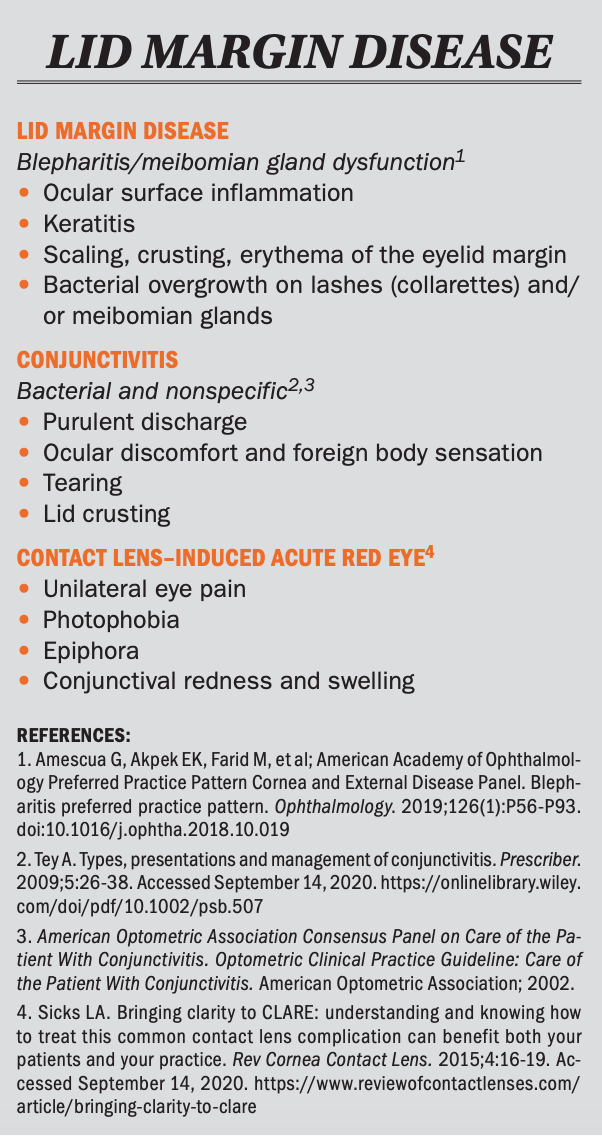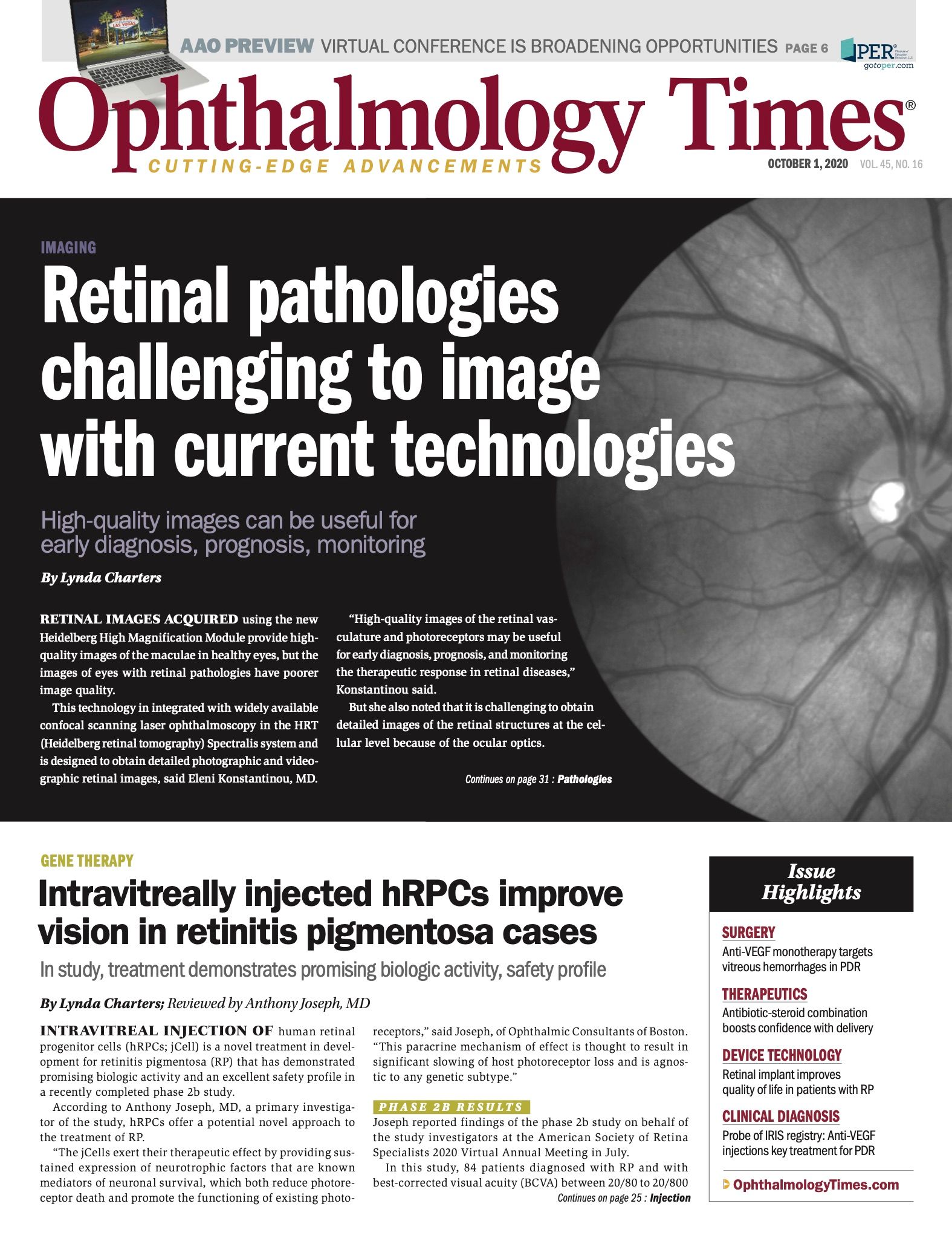Publication
Article
Digital Edition
Antibiotic-steroid combination boosts confidence with delivery
Author(s):

Special to Ophthalmology Times®
Due to the coronavirus disease 2019 (COVID-19) pandemic, our practice was closed from the end of March through April to everyone except patients with emergent conditions.
During this time, I quickly ramped up telemedicine visits for almost all cases that I handled, “seeing” approximately 100 patients.
Thanks to the Centers for Medicare & Medicaid Services relaxing telemedicine regulations and Health Insurance Portability and Accountability Act rules, I was able to use Zoom, FaceTime, and even Facebook Messenger—whatever the patient was most comfortable with—for my virtual consultations, most with patients suffering from acute ocular surface disease (OSD) exacerbations such as blepharitis, meibomian gland dysfunction (MGD)–associated conjunctivitis, contact lens–related red eye, lid disease, severe allergies, and ocular rosacea.

Related: Amid pandemic, friendly bugs can help protect the eye from infection
In the absence of a slit-lamp examination to diagnose these acute OSD patients, I found that treating with tobramycin 0.3%/dexamethasone 0.05% ophthalmic suspension (Tobradex ST; Eyevance Pharmaceuticals) allowed me to cover all the bases for conditions that typically involve mixed mechanisms.
The product contains the antibiotic tobramycin combined with a reduced concentration of dexamethasone, compared with the standard version, which has twice the concentration of anti-inflammatory agent (0.1%). In addition, Tobradex ST has a higher viscosity on the ocular surface, which leads to increased retention time and improved bactericidal activity.1
The drop’s novel xanthan gum delivery technology, termed XanGen by the company, enhances ocular surface retention.
I use tobramycin 0.3%/dexamethasone 0.05% ophthalmic suspension as a bit of a “catch all” product. I am finding it especially beneficial when it comes to confidently treating OSD patients via telemedicine.
Related: Spotlighting telemedicine in the year of a pandemic
Clinical investigations into the pharmacokinetics of the ST formulation have found that ocular tissue concentrations of tobramycin were up to 12.5-fold greater with Tobradex ST compared to original Tobradex.1
At 10 minutes postinstillation, the concentration of tobramycin in the tear film was about 8 times higher for ST compared to the original agent.1
Comorbid OSD plus more screen time
Screen time is up. Patients are spending more time at home as a result of the pandemic and as an increasing number of offices make working remotely a permanent arrangement.
For patients with chronic ocular surface conditions, including dry eye, MGD, or blepharitis, this increase in screen time can lead to worsening of redness, burning, and irritated eyes. Patients wind up turning to self-treatment.
This is where tobramycin 0.3%/dexamethasone 0.05% ophthalmic suspension fits in, not as a long-term therapy, but rather for addressing acute exacerbation, calming inflammation, and treating disease.
Related: Novel dexamethasone formulation shows efficacy and safety with once-daily use
Patients may develop blepharoconjunctivitis from chronic computer use, subsequently inhibiting their ability to work or making it difficult to just keep their eyes open.
Compounded by the cosmetic problem of having bloodshot eyes when they need to be on professional Zoom calls, patients can have a true emergency for which they need fast relief.2
The combination tobramycin-dexamethasone drop in the ST formula is appropriate for acute exacerbations from a broad category of ocular surface diseases.
This includes situations like inflamed exposure dry eye as a result of staring at the computer or inflammation associated with blepharitis, MGD, or ocular rosacea.
Conclusion
Because the COVID-19 environment is our new reality, telemedicine will only increase in importance for our patients and our practices.
In this setting, the safety and efficacy of the agents we prescribe are even more crucial. Tobramycin 0.3%/dexamethasone 0.05% ophthalmic suspension is indicated for steroid-responsive inflammatory ocular conditions in which a corticosteroid is appropriate and superficial bacterial ocular infection or a risk of bacterial ocular infection exists.
Related: Pearls for practicing in the COVID-19 era
Moreover, the ST formulation uses pharmaceutical-grade xanthan gum to stabilize the combination and allow greater delivery and ocular surface retention of tobramycin and dexamethasone.
The adverse effect profile is also very favorable.
About the author
Ranjan P. Malhotra, MD
p: 314/966-5000 e:ranjanmalhotramd@gmail.com
Malhotra is in private practice at Ophthalmology Associates, Cornea and LaserVision Institute, St. Louis, Missouri. He is a consultant to Eyevance.
---
References
1. Scoper SV, Kabat AG, Owen GR, et al. Ocular distribution, bactericidal activity and settling characteristics of TobraDex ST ophthalmic suspension compared with TobraDex ophthalmic suspension. Adv Ther. 2008;25(2):77-88. doi:10.1007/s12325-008-0019-9
2. Torkildsen GL, Cockrum P, Meier E, Hammonds WM, Silverstein B, Silverstein S. Evaluation of clinical efficacy and safety of tobramycin/dexamethasone ophthalmic suspension 0.3%/0.05% compared to azithromycin ophthalmic solution 1% in the treatment of moderate to severe acute blepharitis/blepharoconjunctivitis. Curr Med Res Opin. 2011;27(1):171-178. doi:10.1185/03007995.2010.539603

Newsletter
Don’t miss out—get Ophthalmology Times updates on the latest clinical advancements and expert interviews, straight to your inbox.




